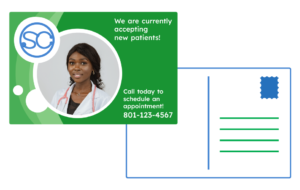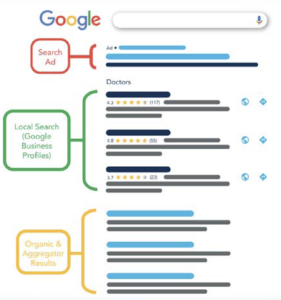Why Your Healthcare Marketing Strategy Isn’t Working & How to Fix It
Are you frustrated by the poor results you get from your healthcare marketing activities? Many healthcare providers are disappointed when their marketing efforts fail to pay off, especially when it seems that all of their competitors are clearly thriving. This leads them to believe that healthcare marketing simply isn’t for them or that it’s not worth investing in.
If you’re in a similar situation and thinking about giving up on your marketing efforts, let’s stop for a second and think about what causes these poor results you’re facing. Have you developed a detailed strategy before engaging in any healthcare marketing activities? Are you fully implementing the strategy instead of doing only certain aspects of it? Are you constantly tracking and analyzing your results, so you can optimize your healthcare marketing strategy?
In reality, healthcare marketing can bring you great results. It has the potential to improve your reach, increase the influx of patients, keep your brand at the top of their minds, and help you achieve a positive ROI. However, you can’t do it randomly or partially and just hope for the best.
Why Is a Healthcare Marketing Strategy Important?
 Healthcare marketing strategy involves different tactics designed to attract patients, guide them through their healthcare journey, and keep them engaged with your healthcare organization. It doesn’t matter if you’re a doctor, hospital, healthcare provider, or marketer. Investing in strategic healthcare marketing helps you streamline your processes, be more organized, stand out among competitors, drive engagement, increase business growth, and reduce marketing costs.
Healthcare marketing strategy involves different tactics designed to attract patients, guide them through their healthcare journey, and keep them engaged with your healthcare organization. It doesn’t matter if you’re a doctor, hospital, healthcare provider, or marketer. Investing in strategic healthcare marketing helps you streamline your processes, be more organized, stand out among competitors, drive engagement, increase business growth, and reduce marketing costs.
Creating a marketing strategy for your healthcare organization depends on a number of factors — the type of patients you want to attract and engage, your goals, and your financial resources. Another deciding element is how much time and effort you can devote to implementing this strategy and measuring the results it brings you. Also, whatever activities you decide to use, it’s important to be consistent and make sure all elements support each other. For example, if you’re doing a mental health campaign and publishing posts about depression on social media channels, don’t mix these posts with links to your blog articles about how to tell if you’re pregnant.
How to Get Better Results from Your Healthcare Marketing Efforts?
For your healthcare marketing strategy to be effective, make it a policy to always plan, track, and optimize. After creating a well-thought-out plan based on thorough research, make sure to monitor the activities you implement as part of your healthcare marketing strategy and track the results they bring you. This way you can determine what’s working and what isn’t, optimize or replace some of the activities, and ensure better results.
Also, it’s equally important to fully implement all the elements of your healthcare marketing strategy instead of doing them partially. Here are some examples of activities that healthcare providers might be doing wrong when in fact they can easily fix them without any additional investments and turn them to their advantage:
Postcards
 The majority of healthcare providers use postcards to attract new patients, but they usually send them to entire zip code areas, resulting in huge costs. When individuals receive dozens of letters and brochures, adding one more postcard from your practice to the stack doesn’t guarantee that they will ever see or open it.
The majority of healthcare providers use postcards to attract new patients, but they usually send them to entire zip code areas, resulting in huge costs. When individuals receive dozens of letters and brochures, adding one more postcard from your practice to the stack doesn’t guarantee that they will ever see or open it.
The thing that can transform this approach is knowing where your prospective patients are and what services they are likely to need. Predictive targeting is used to predict the likelihood of particular health conditions or the likelihood that a patient will respond to a particular treatment. Based on this, you can identify areas with a high concentration of at-risk patients to send postcards to, and save a lot of money while ensuring better results.
Another helpful option is adding call trackers to things like phone numbers or QR codes. Knowing which of your new patient appointments are coming from the postcards you sent helps you determine if this campaign brings you the desired ROI, so you can decide if it’s worth the investment you’re making.
Google Business Profiles
 Another common situation is that healthcare providers have Google Business Profiles (GBPs), but fail to claim and optimize them. This makes them think that GBPs are of little use when, in reality, they’re not using them to their full potential. The information on their GBPs isn’t available or complete, they have little or no reviews, and they don’t post or update anything.
Another common situation is that healthcare providers have Google Business Profiles (GBPs), but fail to claim and optimize them. This makes them think that GBPs are of little use when, in reality, they’re not using them to their full potential. The information on their GBPs isn’t available or complete, they have little or no reviews, and they don’t post or update anything.
In fact, GBPs are one of the best free ways to improve your local ranking and attract new patients. If you have a robust profile for each of your locations and physicians, consumers are nearly 3 times more likely to consider your business reputable and 70% more likely to visit your physical location. At the same time, if you fail to provide accurate, regularly updated information, Google won’t consider you relevant and you may not show up where you’d like to in search results.
Paid Advertising
 When healthcare providers want to appear at the forefront of potential patients who are googling for the types of services they offer, they consider paid advertising as one of the fastest and easiest ways to do this. They may also dive headlong into buying ads without a sound strategy and end up being even more frustrated because their spending doesn’t reflect their desired outcomes.
When healthcare providers want to appear at the forefront of potential patients who are googling for the types of services they offer, they consider paid advertising as one of the fastest and easiest ways to do this. They may also dive headlong into buying ads without a sound strategy and end up being even more frustrated because their spending doesn’t reflect their desired outcomes.
A number of reasons may lead to this. Their targeting may be off, they select a broad audience thinking that this will result in higher profits, they don’t know how to use data in a HIPAA-compliant way, they don’t use the right ad format, or fail in tracking and optimizing.
Still, while it can be challenging, paid advertising can also benefit you in a number of ways. However, before choosing your audience, you need to set your goals. It’s not the same if you’re trying to target a specific service of yours or a health condition you treat or trying to increase your visibility in a widened geolocation.
It’s also important to identify the types of keywords that might be most successful for you. For example, the more specific and less common your keywords are, the cheaper the ad campaign may be. You also need to align your ad strategy and budget to maximize the impact of your ads. Other things to consider are creating enticing ad copy, optimizing your web page’s performance, using retargeting within the HIPAA scope, but also measuring the success of your campaign to make future edits or justify the advertising expense.
Website
Having a website is an integral part of any healthcare marketing strategy. But not just any website — it should be optimized, mobile responsive, and designed to provide a great user experience as well as relevant and authoritative content.
In reality, healthcare providers don’t consider all of these elements important and when, for example, patients don’t use appointment forms and fail to schedule online, they end up thinking that no one uses their website, so there’s no need to invest in it. But, let’s go back to this appointment form and look at it with your patients’ eyes — it may be too complicated and confusing for them or it may involve a multi-step process only to leave them wondering if they even managed to make an appointment. So, in the end, it’s not up to them, it’s up to you. You failed to provide an opportunity for your patients to use your website and, in return, benefit from it.
Social Media
Healthcare is an increasingly competitive field and social media is one way to attract patients, connect with them, and provide valuable information to help them make the best decision for their health. To take advantage of the different benefits that social media provides, it’s important to take the right approach and overcome common challenges. For example, healthcare providers try to establish a presence on every social media channel instead of defining those used by their audience. They also tend to post generic and branded photos or fail to make a plan and post content randomly. At the same time, there are providers who feel safer not using social media at all because of HIPAA restrictions.
On the other hand, there are different, proper ways for healthcare providers to realize the full potential of social media as part of their healthcare marketing strategy. To do so, it’s important to have a clear understanding of your target audience and focus on social media platforms where your patients are present, so you can interact with them. It’s also important to provide different types of content — informative, educational, and engaging posts in various formats that portray your work and make you more accessible. It’s also useful to make and follow a social media content calendar and make sure that you post regularly.
Consistent Tracking of Healthcare Marketing Campaigns
Having a healthcare marketing strategy is critical for every business, but it’s not always easy to know if you’re doing it right. Tracking activities and results they bring you is the only way to know what works and doesn’t, so you can adjust your strategy accordingly.
Tracking your marketing efforts is based on collecting data related to different marketing activities and may include everything from your website traffic to your Facebook page likes. Each marketing strategy provides you with the possibility to measure its effectiveness and make adjustments.
For example, with Google Ads, you get access to information such as how many people have seen your ads, clicked on them, visited your website, and even called you. If it turns out that you’re paying for ads that aren’t converting visitors into patients, ask yourself why this is. Have you really invested your thoughts and efforts into making ads work or are there additional steps you can take to optimize them? Either way, unless you track your results, you can’t really know where you stand and what to do to get better results.
Tie All of Your Healthcare Marketing Efforts Together
By this point, you should understand the importance of a healthcare marketing strategy, implementing it to its fullest extent, and measuring the results it brings you. If you’re still approaching healthcare marketing halfheartedly, don’t expect to go far.
It’s true that healthcare marketing is complex, multi-channel, and multi-touch, but when you do it based on a solid strategy, you’re bound to see results. What’s more, if you keep measuring and know what and how you’re doing, you can effectively estimate your ROI through your marketing efforts.
It’s also understandable if you find all of this overwhelming. After all, you’re here to provide quality care to your patients and not to be a marketing expert. With SocialClimb’s comprehensive and HIPAA-compliant platform, you don’t have to be. Instead, you can use our intuitive tools to address every aspect of your healthcare marketing strategy. We help you make the most of your allocated budget and start getting results by measuring your marketing efforts from one place. This way, you can tie together all elements of your healthcare marketing strategy and use the valuable data you’ll collect along the way to keep it optimized.











